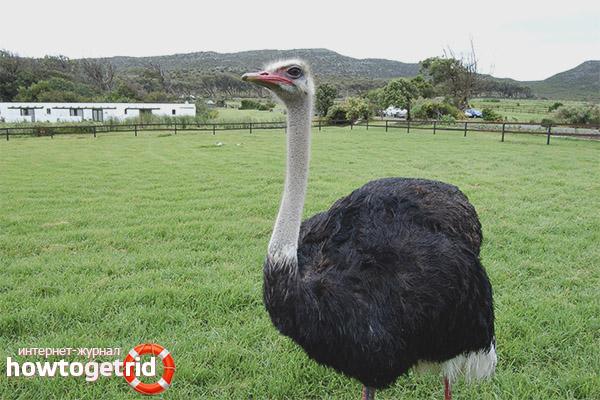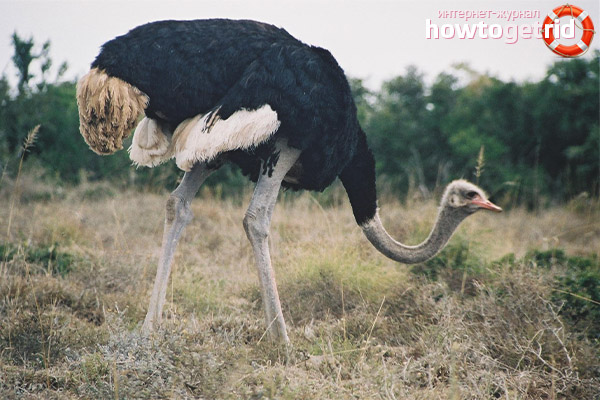The content of the article
Today, the ostrich is the largest bird species among all living on the planet. They grow up to 2.5 m in height, and an adult can weigh about 180 kg. They feed mainly on vegetation, but sometimes they can eat insects, as well as small invertebrate animals. From time to time, this bird can swallow even an inedible object. It can be a piece of cloth, sand or some kind of iron object. Such items help digest food.
Appearance
These birds have very large eyes with eyelashes to prevent the ingress of sand and dust. Their body has an oval shape. The plumage is very soft. Chicks have plumage of a darker shade, and brighten over time. Their legs are also very large. This part of the body is simply the pride of a bird and can fulfill a protective function. Their limbs are long and strong. On each leg, only 2 toes. The large length and strength of the legs allows the bird to shelter from danger. If necessary, the ostrich is able to run very quickly - up to 70 km / h.
Their neck is also very long. This allows the bird to take leaves from the trees and see the possible danger. Their wings are also quite powerful and well developed, but due to the enormous weight they cannot fly.
The ostrich uses its wings during the mating season to attract a couple. They perform a mating dance, which is similar to the capercaillie dance. One male may have several partners, but among them he will choose one, which he will then help with offspring.
The entire body of the bird is evenly covered with a soft feather. Feathers do not adhere to each other, which distinguishes the ostrich from other birds. The chest muscles in them are not very developed. There is no keel in the chest. Therefore, their chest is not convex, but flat. The wingspan can reach 2 m. They can’t fly either because they don’t have collarbones and their muscles are too weak. But in general, the ostrich’s bones are strong. They have no goiter. Another difference from other birds is that they have feces and urine excreted separately.
Views
Habitat
The habitat of these birds is on the African continent. They live both south and north of the equator. Often these birds can settle next to other representatives of the African fauna. Their neighbors are antelopes or zebras. These animals treat the bird peacefully, and may even give way to a good place to find more food.
Thanks to good hearing and vision, as well as high altitude, the enemy is quite difficult to get close to the bird unexpectedly. An ostrich will notice a threat before other animals. At the same time, he immediately warns other animals nearby. He sees a predator in advance, when he has not yet reached the potential victims, even a few kilometers. As soon as the ostrich sees danger, he immediately screams, and then runs away.
Features

As already mentioned, they cannot fly. They simply are not able to do this because of the structural features of their body, as well as the large mass. But they run even faster than a horse. The chicks that were born just a month ago can already run at a speed of about 50 km / h. But not only this distinguishes them from other birds.Ostriches also differ from them in that there are only 2 fingers on their feet. One of the fingers is keratinized. This feature makes the process of walking and running convenient. There is a large claw on the thumb, which makes the foot look like a camel's hoof. If we translate the name of this species into Russian, we get the name "Sparrow-camel."
Breeding
Another distinctive feature of the species is the size of the eggs, which are the largest in weight and size compared to any other. By weight, it is comparable to 24 chicken eggs. If we take the ratio of the size of the egg and the bird itself, then it will be slightly smaller than, for example, in chickens.
Among the females that the male fertilizes, there is one dominant. She is engaged in hatching. And in this case the male is engaged in arranging the nest. The remaining females lay eggs in this nest. The eggs of the dominant female are in the center. This is still a privilege. She has been hatching all day. And at night the leader replaces her.
Ostriches
The hatching process lasts a relatively long time - about 40 days. Each chick that has just appeared weighs at least 1 kg. But they grow quite quickly. After 2 months they are covered with plumage. Ostriches quickly grow stronger, and soon they can run as fast as adults. Parents take care of them for a long time - it can last up to 2 years. After that, young ostriches leave the nest to create their own family.
Ostriches never throw chicks. If several families live in one locality, they may even try to take ostriches under the care of strangers. Therefore, in Africa, you can meet families of ostriches, consisting of a huge number of chicks. There may even be about 300.
Hunting and breeding
At all times, these birds were intensively exterminated. This continues today. The value for the hunter is the plumage of a bird. They are used for interior decoration, various original costumes. Often the feather of this bird is an element of the outfit developed by the fashion designer. In addition, they have thin and soft skin. At the same time, it is notable for its considerable strength. Today, accessories and clothes are made from it.
Ostrich meat, which has excellent taste, is also of value. Even sophisticated foodies will like it. The eggs of these ratites are also consumed. They are large, rich in useful substances.
These reasons make a person again and again go hunting for an ostrich. Active extermination led to the fact that instead of 5 species of birds only 4 remained. But today, many people are more and more thinking about nature. Therefore, ostrich farms have become very widespread. Here, birds are bred specifically in order to get valuable meat, feathers and eggs from them. This was a great idea for the original business. In addition, thanks to such farms, ostriches living in nature are still less destroyed.
These ratites are able to live in a variety of conditions. Therefore, they are bred by enterprising businessmen, not only in Africa, but also in latitudes with a temperate climate. In addition, there are many zoos and reserves with ostriches. All this suggests that the extinction of birds is no longer threatening.
Interesting Facts
- They love to crumble in dust. This procedure protects them from parasites, and also prevents waterlogging of the wings. All herds can take such baths at the same time.
- Since their legs are very large, powerful, ostriches use them for self-defense. With one successful blow of such a leg, a bird can even kill a lion.
- Their eyes are the largest not only among all birds, but also among all hired animals. Interestingly, their brains are smaller.
- When the leader sees a predator approaching the family, he immediately reports an impending danger.At the same time, he makes a sound similar to the roar of a lion.
- With a shortage of fresh water, they may well drink salty. But the best option is still fresh water.
- The egg shell is very strong. Residents of African tribes used it as utensils for storing water. And when it came to the countries of Europe, it served as the basis for the manufacture of cups and other products.
- They are very caring parents, and protect ostriches from predators. In case of danger, an adult pretends to be injured in order to divert the predator as far as possible. And then she quickly runs away from him. Other birds protect the chicks at this time.
- They live in a big family. To protect themselves from the enemy, several individuals are alternately on duty at night.
- There is a widespread belief that, in danger, they bury their heads in the sand. But this is not so. They just can pretend to be dead. When they lie on the ground, the body from afar can be well seen, and the head of the bird is not visible. Therefore, everything looks as if there is no head on the surface.
Video: African Ostrich (Struthio camelus)











Submit